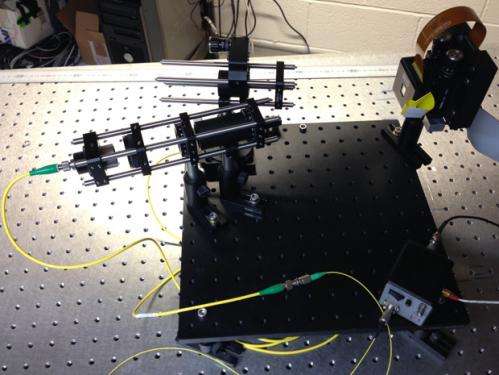February 16, 2015 weblog
Gigabits per second feat: Indoor optical wireless link explored

Attention to optical fiber communication networks has been paid in a recent paper showing their potential. Optical fiber communication networks can provide terabit aggregate capacities to buildings and offices in modern cities whereas practical wireless systems are orders of magnitude below this capacity. The authors reported on an indoor optical bidirectional wireless link with an aggregate capacity over 100 Gb/s. The link operated over ~3 m range at 224 Gb/s (6 x 37.4 Gb/s) and 112 Gb/s (3 x 37.4 Gb/s) with a wide field of view (FOV) of 60° and 36°, respectively. The authors said that this was the first demo of a wireless link of this type with a field of view that offers practical room-scale coverage.
Their paper, "Beyond 100-Gb/s Indoor Wide Field-of-View Optical Wireless Communications," appears in Photonics Technology Letters, IEEE, a semimonthly carrying contributions about photonic-lightwave components and applications, laser physics and systems, and laser-electrooptic technology. IEEE Spectrum's Neil Savage said: "With a 60° field of view, the team was able to transmit with an aggregate bandwidth of 224 gigabits per second." Savage translated their concept: "The light that zips data across the Internet's backbone used to stop a long way from the data's final destination. Now it goes all the way to your home. Why not go the last step and take the light all the way to the computer or TV, projecting it through the air over the last few meters and only converting it to an electronic signal at the end? Oxford University is doing just that with a system that takes light from the fiber, amplifies it, and beams it across a room to deliver data at more than 100 gigabits per second."
Savage said "with light, there's no worry about sticking to a limited set of radio frequencies." He quoted Ariel Gomez, a Ph.D. student in photonics at Oxford University and one of the authors of this paper: "If you're in the optical window, you have virtually unlimited bandwidth and unlicensed spectrum."
In the bigger picture, Dominic O'Brien, Professor of Engineering Science, University of Oxford, who directed the work, has stated that. "Through advances in visible light communications, we aim to gain improvements in the bandwidth and/or efficiency of a data network."
The IEEE Spectrum headline indicates the goals of O'Brien and colleagues: "Li-Fi-like System Would Bring 100-Gbps Speeds Straight to Your Computer."
O'Brien is a member of a project for Ultra-Parallel Visible Light Communications, a partnership among research groups at five institutions, also including universities of Edinburgh, Strathclyde, St. Andrews, and Cambridge. Savage wrote that "One of their goals is to develop LiFi, which uses the light that's also illuminating a room as a way to send data signals. He says LiFi usually refers to schemes based on visible wavelengths of light, whereas this system relies on infrared light at 1550 nm, which is used in telecommunications."
The project team's website stated that "recent trends in both guided wave (polymer optical fiber (POF) and polymer backplane) and free-space combined illumination and communications, with GaN LEDs especially, raise the tremendous prospect of an entirely new form of high bandwidth communications infrastructure to complement, enhance, and in some circumstances supersede existing systems."
More information: Beyond 100-Gb/s Indoor Wide Field-of-View Optical Wireless Communications, Photonics Technology Letters, Volume:27 Issue:4. ieeexplore.ieee.org/xpl/articl … jsp?arnumber=6967750
Abstract
Optical fiber communication networks can provide terabit aggregate capacities to buildings and offices within modern cities. Practical wireless systems are orders of magnitude below this capacity. In this letter, we describe an indoor optical bidirectional wireless link with an aggregate capacity over 100 Gb/s. The link operates over ~3 m range at 224 Gb/s (6 x 37.4 Gb/s) and 112 Gb/s (3 x 37.4 Gb/s) with a wide field of view (FOV) of 60° and 36°, respectively. To the best of our knowledge, this is the first demonstration of a wireless link of this type with a FOV that offers practical room-scale coverage.
© 2015 Tech Xplore




















